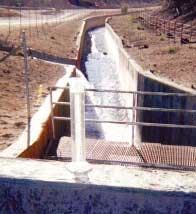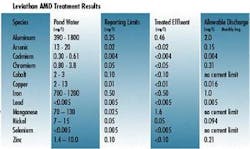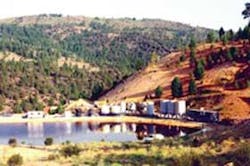By David Siskind
For 16 years acid mine drainage (AMD) with high concentrations of metals and sulfate was collected in holding ponds at the Leviathan Mine and allowed to overflow to a creek untreated. To prevent further overflows of the acid mine drainage, Unipure Environmental was contracted to design, build and operate a 300 gpm treatment system.
The company successfully reduced equipment lead-time, capital costs and overall operating costs by installing standard treatment modules in a two-stage (bi-phasic) co-precipitation system. The first stage process removes an iron-arsenic complex, thereby minimizing the generation of arsenic contaminated hazardous solids. The second stage takes advantage of the high concentrations of iron in the pretreated AMD to remove the remaining arsenic, cadmium, chromium, cobalt, copper, manganese, nickel and zinc. The second stage process produces non-hazardous solids that are land applied on the site.
The Leviathan Mine is an inactive copper and open pit sulfur mine 30 miles south of Lake Tahoe. The retention ponds were designed and built by the State of California to prevent direct discharge of untreated acid mine drainage into Leviathan Creek. The ponds were intended to catch and evaporate the drainage, but the available land space was insufficient to evaporate enough AMD. As a result, the ponds were allowed to overflow every spring when the creek was expected to be running high enough to provide attenuation.
The drainage contains substantial amounts of iron, aluminum, arsenic, nickel, and sulfate, as well as trace amounts of cadmium, chromium, cobalt, copper, manganese and zinc. In late 1998, the California Regional Water Quality Control Board (RWQCB) committed to running a full-scale pilot plant to prove the feasibility of economically treating the acid mine drainage.
In June 1999 the board contracted Unipure to design and supply a 300 gpm pilot system on a lease basis. Time was of the essence as the window for operations at Leviathan is very short due to its high elevation (7100 feet), severe winter, and limited site accessibility.
Unipure applied its experience with its patented iron co-precipitation process by using the iron in the AMD to remove all the dissolved metals. Off-the-shelf Unipure treatment equipment was well suited to the Leviathan AMD and site conditions. Only minor modifications to the standard equipment designs were required to treat the high metals loading, high total dissolved salt loading and the acidity of the drainage.
Each 300 gpm treatment train consists of a 9,000 gallon well-mixed reaction vessel, an inclined plate separator, solids storage capacity and a filter press. Unipure modularized the chemical feed systems, instrumentation, transfer pumps and control panels to minimize installation time and costs. The company engineered, fabricated and delivered the two treatment trains to the site in six weeks. Not only was the project schedule met but also the use of standard designs minimized engineering and equipment costs.
Bi-Phasic Treatment Process
When treatment started in 1999, the stored AMD contained on average 1200 mg/l iron, 800 mg/l aluminum, 20 mg/l arsenic, 15 mg/l nickel and trace concentrations of the other metals. Sulfate concentrations ranged from 8,500 to 30,000 mg/l. The pH ranged from 2.3-2.5 standard units. In order for a treatment process to be implemented economically, the amount of hazardous waste requiring off-site disposal had to be minimized. The RWQCB in conjunction with UC Davis performed bench-scale tests of a bi-phasic approach to treat the AMD.
The bi-phasic system employs two co-precipitation processes in series. In the first treatment phase more than 90% of the arsenic is co-precipitated by iron under acidic conditions. The iron-arsenic precipitate is flocculated with anionic polymer and then separated via gravity separation in a clarifier. All other metals and sulfate remain in solution and pass to the second phase reaction vessel. The first phase precipitates are a non-RCRA hazardous waste due to their high arsenic content and must be disposed of in a designated facility.
In the second treatment phase hydrated lime is used to neutralize the pretreated AMD, precipitating the remaining iron and other heavy metals. The second co-precipitation process takes advantage of the residual iron and aluminum in the AMD to bolster the removal efficiencies of the other metal contaminants.
The co-precipitation process allows the treatment system to achieve effluent concentrations well below the theoretical insolubilities for the individual metal hydroxides. An anionic polymer is added to assist in solids flocculation and then the remaining solids are separated from the treated water. The overflow from the second phase clarifier is discharged to Leviathan Creek without requiring filtration or final pH adjustment.
System Optimization
The 1999 pilot test proved successful. The bi-phasic process produced compliant effluent, demonstrated reasonable chemical usage rates and proved that non-hazardous second phase filter cake can be generated. The actual amount of hazardous material shipped off-site was less than 10 percent of the total generated.
With the bi-phasic process successfully demonstrated, the RWQBC initiated the next phase of the project and focused on optimizing the bi-phasic process operation and minimizing operator requirements at the remote site.
In May 2000 the Leviathan Mine was listed as a Superfund Site. More stringent effluent requirements and increased scrutiny followed the listing. This added urgency to optimizing the system's operation. Unipure's experience with similar facilities lead to the RWQCB retaining the company to convert the system from a temporary pilot unit to a long-term plant, to start the treatment processes and to supervise the operating subcontractor for the 2000 season.
Based on Unipure's recommendations, different commodity chemicals were used, the chemical injection systems were modified and different process control parameters were tracked which collectively improved the reliability and efficiencies of the system. Due to the recommended changes, the amount of iron co-precipitated in the first phase reaction reduced the total amount of hazardous waste in the second year by 50%.
On-Going Operation
After the successful process optimization effort in 2000, the State of California solicited bids to operate the Leviathan AMD treatment facility in 2001 and 2002. Unipure won the bid, assembled a team of local technicians, re-assembled the winterized system, mechanically commissioned the equipment, operated the facility and winterized the facility. In 2001 nearly 400 tons of second phase precipitate was produced and land applied at the site. Twenty tons of hazardous first phase solids were shipped off-site.
Approximately 6 million gallons of AMD were treated in compliance with the more stringent standards imposed by the EPA and discharged to Leviathan Creek. To further the RWQCB's effort to minimize operator requirements, Unipure installed and demonstrated a control system which allowed unattended operation. Fully redundant instrumentation and safe failure modes prevented any release of incompliant discharge and prevented arsenic contamination of second phase solids.
In 2001, for the first time in 18 years, every pond was pumped dry. By mid-September 2002 the ponds will be emptied again.
About the Author: David Siskind received a BS in Chemical Engineering from Columbia University in 1973. He worked for Dorr Oliver and Graver Water managing water treatment equipment and process development efforts in wastewater, mineral benefaction, oilfield produced waters, and power generation. He currently heads Unipure's Mining Group in the U.S. and has managed the company's efforts at Leviathan Mine since May 2000.





